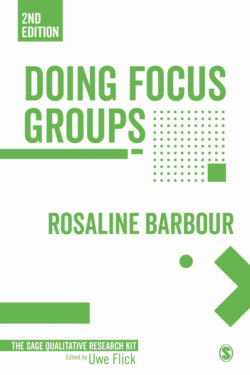Читать книгу Doing Focus Groups - Rosaline Barbour - Страница 11
На сайте Литреса книга снята с продажи.
Objectives
ОглавлениеAfter reading this chapter, you should:
understand the plan of the book;
appreciate how the origins of focus groups have shaped their development;
have an idea of the range of applied and more theoretical usages of the method; and
begin to have an idea of how your own research might benefit from considering some of the approaches taken in different focus group traditions.
Much has changed in the time that has elapsed since the publication of the first edition of Doing Focus Groups. Focus groups have now consolidated their position as an accepted method in the qualitative (and, increasingly, mixed methods) toolkit. Researchers no longer need to invest so much time and energy in justifying to funders and colleagues their choice of focus groups. This is not to say, however, that focus group usage is free of dilemmas and challenges. The varying terms employed by different writers (or disciplinary representatives) who label their method as involving ‘group interviews’, ‘focus group interviews’ or ‘focus group discussions’ reflect different assumptions as to the purpose of the study and the nature and status of the data that are generated. Some usages emphasize the capacity of focus groups to access ‘views’ and may, at times, implicitly reference the quantitative tradition of data collection, privileging the notion of fixed ‘attitudes’. Others focus, either implicitly or explicitly, on an alternative model that emphasizes the potential of focus groups to elicit exchanges between participants as they co-construct perspectives and responses. (This is discussed in more detail in Chapter 3 in relation to ‘epistemological and ontological’ underpinnings of focus group research.) The definition that I continue to apply is suitably broad to afford space for both applied and more theoretical usages of focus groups: ‘Any group discussion may be called a focus group as long as the researcher is actively encouraging of, and attentive to, the group interaction’ (Kitzinger and Barbour, 1999, p. 20).
Being actively encouraging of group interaction relates, most obviously, to running the focus group discussion and ensuring that participants talk amongst themselves rather than interacting only with the researcher, or ‘moderator’. However, it also relates to the preparation required in developing a topic guide and selecting stimulus material that will encourage interaction, as well as decisions made with regard to group composition, in order to ensure that participants will have enough in common with each other to make discussion seem appropriate, yet have sufficiently varying experiences or perspectives in order to allow for some debate or differences of opinion. Likewise, although being attentive to group interaction refers to the process of moderating discussions, with the researcher picking up on differences in views or emphasis of participants and exploring these, it also relates to the importance of paying attention to group interaction: to group dynamics and to the activities engaged in by the group – whether this be forming a consensus, developing an explanatory framework, interpreting health promotion messages, or weighing up competing priorities. Later chapters in this book are concerned with providing advice on all of these aspects of research design, the running of focus groups and analyzing the data generated.
In an earlier edited collection, we (Kitzinger and Barbour, 1999) argued that many researchers were unimaginatively ‘adopting’ focus groups rather ‘adapting’ them, and this is still the case in some quarters almost 20 years later.
As with the first edition, the advice that follows is offered within a context that views qualitative research as a ‘craft skill’ (Seale, 1999) and that recognizes that what works for one exponent of focus groups may not work for another – perhaps on account of their own characteristics (gender, age, ethnicity), or disciplinary predisposition (which depends on their original training and theoretical leanings), or conceptual approach (i.e. how individuals go about learning, theorizing and reasoning). Likewise, approaches developed to address the requirements of a specific research project may not translate well to another, where the data are being generated for a different purpose or which is engaging with another group of people.
This book is not intended as a manual, but aspires to encouraging thoughtful and imaginative use of focus groups. Through contextualizing issues and illustrating dilemmas with reference to real-life research projects, it aims to offer potential – sometimes partial – solutions and, at the very least, cautions against employing ‘quick fixes’.
